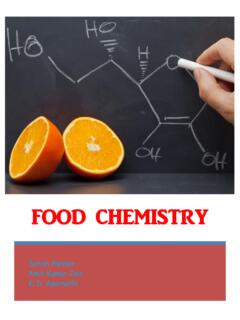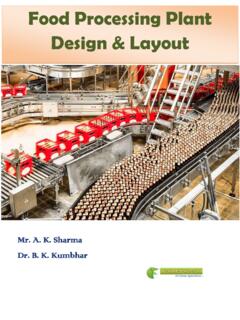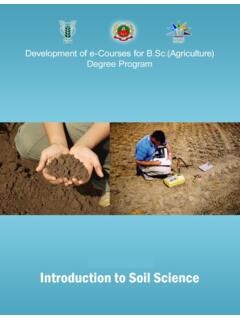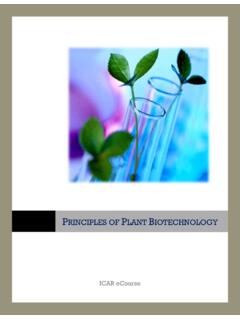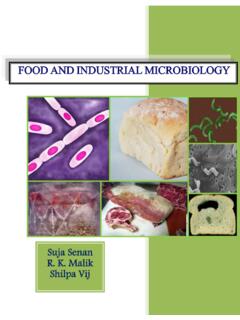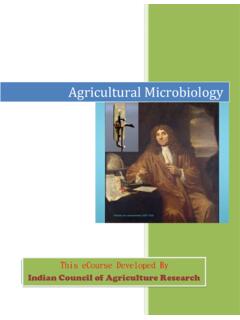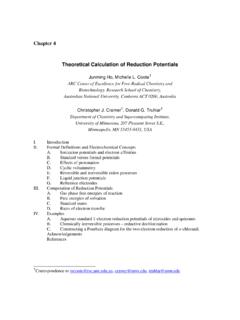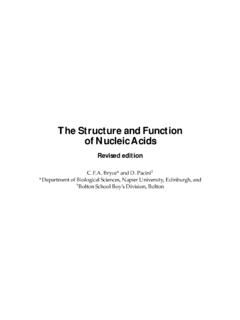Transcription of Fundamentals of Biochemistry - AgriMoon
1 Fundamentals of Biochemistry Fundamentals of Biochemistry AUTHOR TNAU Index Lecture Name Page No 1 introduction , Carbohydrates importance &classification 4-10 2 Occurrence and Structure of Monosaccharides 11-17 3 Structure of Disaccharides & Polysaccharides 18-29 4 Muta rotation, optical activity and physical properties of sugars 30-32 5 Chemical properties of carbohydrates 33-34 6 Lipids - introduction , importance and classification 35-37 7, 8, 9 Plant fatty acids 38-51 10 Physical constants 52-55 11 Amino Acids and Protiens 56-63 12 Proteins 64-70 13, 14 Conformation of protein 71-80 15 Enzymes 81-85 16 Mechanism of Enzyme Action 86-93 17 Mix Term Examination 94 18 Apoenzymes, coenzymes and cofactors, Isozymes 95-97 19 - 24 Metabolism of Carbohydrate 98-111 25 Lipases and Phospholipases 112-114 26 Oxidation of Fatty Acids 115-119 27 Fatty acid and triacyl glycerol biosynthesis 120-126 28 Transamination, Deamination and Decarbixtlation 127-130 29 Ammonia assimilating enzymes, GDH, GS and GOGAT 131-133 30 Secondary Metabolities- Occurrence, classification and functions of phenolics 134-135 Lecture-1 introduction , Carbohydrates importance &classification Biochemistry , as the name implies.
2 Is the chemistry of living organisms. Living organisms, whether they are microorganisms, plants or animals are basically made up of the same chemical components. Biochemistry is the study of the way in which these components are synthesized and utilized by the organisms in their life processes. It bridges the gap between the conventional chemistry and biology. In other words, life is nothing but thousands of ordered chemical reactions or chemistry is the logic of all biological phenomena. History of Biochemistry During 17th and 18th centuries, important foundations were laid in many fields of biology.
3 The 19th century observed the development of concepts - the cell theory by Schleiden and Schwann, Mendel s study of inheritance and Darwin s theory of evolution. The real push to Biochemistry was given in 1828 when total synthesis of urea from lead cyanate and ammonia was achieved by Wohler who thus initiated the synthesis of organic compound from inorganic compound. Louis Pasteur, during 1857, did a great deal of work on fermentations and pointed out the central importance of enzymes in this process. The breakthrough in enzyme research and hence, Biochemistry was made in 1897 by Edward Buchner when he extracted enzyme from yeast cells in crude form which could ferment a sugar molecule into alcohol.
4 Neuberg introduced the term Biochemistry in 1903. The early part of 20th century witnessed a sudden outburst of knowledge in chemical analysis, separation methods, electronic instrumentation for biological studies (X-ray diffraction, electron microscope, etc) which ultimately resulted in understanding the structure and function of several key molecules involved in life processes such as proteins, enzymes, DNA and RNA. In 1926, James Sumner established the protein nature of enzyme. He was responsible for the isolation and crystallization of urease, which provided a breakthrough in studying of the properties of specific enzymes.
5 The first metabolic pathway elucidated was the glycolytic pathway during the first half of the 20th century by Embden and Meyerhof. Otto Warburg, Cori of Biochemistryand Parnas also made very important contributions relating to glycolytic pathway. Krebs established the citric acid and urea cycles during 1930-40. In 1940, Lipmann described the central role of ATP in biological systems. The Biochemistry of nucleic acids entered into a phase of exponential growth after the establishment of the structure of DNA in 1953 by Watson and Crick followed by the discovery of DNA polymerase by Kornberg in 1956. From 1960 onwards, Biochemistry plunged into an interdisciplinary phase sharing much in common with biology and molecular genetics.
6 Frederick Sanger s contributions in the sequencing of protein in 1953 and nucleic acid in 1977 were responsible for further developments in the field of protein and nucleic acid research. The growth of Biochemistry and molecular biology was phenomenal during the past two decades. The development of recombinant DNA research by Snell and coworkers during 1980 allowed for further growth and emergence of a new field, the genetic engineering. Thus there was progressive evolution of biology to Biochemistry and then to molecular biology, genetic engineering and biotechnology. CARBOHYDRATES Compounds with empirical formula, (CH2O)n, were called as carbohydrates (hydrates of carbons).
7 With the discoveries of many diverse carbohydrates it was noticed that many, but not all, carbohydrates have the above empirical formula; some also contain nitrogen, phosphorus or sulfur. There are some carbohydrates (derivatives) that of Biochemistrydo not possess (CH2O)n. On the other hand, there are a few non-carbohydrate compounds like lactic acid with empirical formula (CH2O)n. Hence, carbohydrates are chemically defined as polyhydroxy aldehydes or ketones, their derivatives and their polymers. Occurrence and importance The carbohydrates comprise one of the major groups of naturally occurring biomolecules.
8 This is mainly because; the light energy from the sun is converted into chemical energy by plants through primary production and is transferred to sugars and carbohydrate derivatives. The dry substance of plants is composed of 50-80% of carbohydrates. The structural material in plants is mainly cellulose and related hemicelluloses. Starch is the important form of storage polysaccharide in plants. Pectins and sugars such as sucrose and glucose are also plant constituents. Many non-carbohydrate organic molecules are found conjugated with sugars in the form of glycosides. The carbohydrates in animals are mostly found in combination with proteins as glycoproteins, as well as other compounds.
9 The storage form of carbohydrates, glycogen, found in liver and muscles, the blood group substances, mucins, ground substance between cells in the form of mucopolysaccharides are few examples of carbohydrates playing important roles in animals. Chitin found in the exo-skeleton of lower animals, is a polymer of N-acetyl glucosamine. Carbohydrates are also universally found in other polymeric substances. For example, o Fats are fatty acid esters of a sugar alcohol, glycerol. o Ribose and deoxyribose are constituent of nucleic acids. Moreover, in all living forms, the energy needed for mechanical work and chemical reactions are derived from carbohydrates.
10 Adenosine triphosphate and related substances that contain ribose as a constituent are key substances in energy storage and transfer. The carbon skeletons of almost all organic molecules are derived from carbohydrates. of BiochemistryBesides, the carbohydrates are the basic raw material of many important industries including sugar and sugar products, starch products, paper and wood pulp, textiles, plastics, food processing and fermentation. CLASSIFICATION Carbohydrates are classified into three major groups: Monosaccharides Oligosaccharides Polysaccharides Classification of carbohydrates Monosaccharides (Simple sugars) Oligosaccharides Polysaccharides (Glycans) Low molecular weight carbohydrates and cannot be hydrolysed further Contain 2-10 monosaccharides joined by glycosidic bonds.
